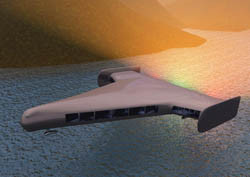Propelling planes into the future
Decreasing the environmental impact of flight is a pillar of the EU's research agenda. Hybrid energy sources are among the novel propulsion concepts shown to decrease power requirements and thus fuel burn and emissions. Concepts include distributed propulsion with multiple propulsive devices or a propulsive fuselage in which the power plant is fully or partially embedded in the airframe. The EU-funded project DISPURSAL (Distributed propulsion and ultra-high by-pass rotor study at aircraft level) implemented potential solutions in realistic aircraft systems. The team focused on two novel designs that take advantage of wake filling and boundary layer ingestion (BLI) commonly used in torpedoes, missiles and ships. The technologies are targeted for entry-into-service in 2035. The distributed multiple-fans concept (DMFC) is a hybrid wing body with multiple BLI fans on the upper side of the fuselage. The propulsive fuselage concept (PFC) integrates an aft-mounted BLI fan that encircles the fuselage and is powered by a gas turbine in the fuselage aft cone. The design also includes two modern and fuel-efficient (ultra-high by-pass ratio) turbofan engines under the wing for redundancy. Scientists evaluated component architectures, airframe-propulsion integration issues, powertrain system design and overall impact on aircraft performance and emissions. Concepts were compared to two other aircraft. The 2035R was a conventional gas turbine whose performance was projected to year 2035 and the SoAR was a year 2000 datum A330-300 aircraft. Advanced flow field simulations supported experimental work. The DMFC and PFC both demonstrated significant improvements in fuel burn and carbon dioxide emissions compared to the SoAR and smaller but important ones compared to the 2035R. Outcomes highlighted the need to lessen the negative effects of BLI to meet emissions reduction targets, but showed that both are likely to meet noise targets for 2035. Results were widely disseminated in scientific journals and via invited presentations at conferences. In addition, a model of the PFC was exhibited at one of the most important international aerospace conferences, the 2014 ILA Berlin Air Show. DISPURSAL demonstrated the benefits of hybrid propulsion concepts and provided a roadmap for further optimisation. Eventual concept implementation could help the EU meet its stringent goals for eco-friendly flight.
Keywords
Propulsion, distributed propulsion, airframe, fuselage, ultra-high by-pass, aircraft

